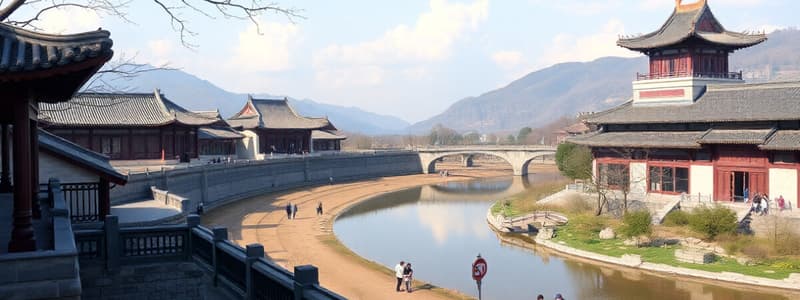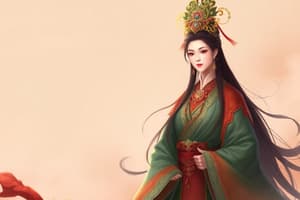Podcast
Questions and Answers
What significant project did Yangdi undertake to connect China's great rivers?
What significant project did Yangdi undertake to connect China's great rivers?
Yangdi built the Grand Canal.
What led to the downfall of Yangdi during his rule?
What led to the downfall of Yangdi during his rule?
High taxes to support construction projects led to farmer revolts, which resulted in Yangdi's death.
Who founded the Tang Dynasty and what was his approach to government officials?
Who founded the Tang Dynasty and what was his approach to government officials?
Taizong founded the Tang Dynasty and restored the civil service examination system for selecting government officials.
What was Empress Wu's significance in Chinese history?
What was Empress Wu's significance in Chinese history?
How did the Tang Dynasty's expansion in Asia impact China?
How did the Tang Dynasty's expansion in Asia impact China?
What was the consequence of the Battle of Talas for the Tang Dynasty?
What was the consequence of the Battle of Talas for the Tang Dynasty?
What characterized the Song Dynasty in contrast to previous dynasties?
What characterized the Song Dynasty in contrast to previous dynasties?
How did Buddhism gain popularity in China during its introduction?
How did Buddhism gain popularity in China during its introduction?
What occurred after the fall of the Tang Dynasty?
What occurred after the fall of the Tang Dynasty?
What role did trade play in the growth of Chinese cities during the Tang Dynasty?
What role did trade play in the growth of Chinese cities during the Tang Dynasty?
What role did Buddhist monasteries play in local communities during the early Tang dynasty?
What role did Buddhist monasteries play in local communities during the early Tang dynasty?
What were the primary concerns of Tang officials regarding Buddhism?
What were the primary concerns of Tang officials regarding Buddhism?
How did Buddhism spread to Japan?
How did Buddhism spread to Japan?
What was the purpose of the civil service examinations established by the Han dynasty?
What was the purpose of the civil service examinations established by the Han dynasty?
What was neo-Confucianism and why was it developed?
What was neo-Confucianism and why was it developed?
Who was Yangming and what changes did he advocate for in neo-Confucianism?
Who was Yangming and what changes did he advocate for in neo-Confucianism?
What was the impact of the civil service examination system on Chinese society?
What was the impact of the civil service examination system on Chinese society?
Why did Confucianism decline after the fall of the Han dynasty?
Why did Confucianism decline after the fall of the Han dynasty?
What specific rules were placed on scholar-officials during the Tang and Song dynasties?
What specific rules were placed on scholar-officials during the Tang and Song dynasties?
How did the Tang and Song rulers view the relationship between education and government corruption?
How did the Tang and Song rulers view the relationship between education and government corruption?
Flashcards
Buddhism in China (Early)
Buddhism in China (Early)
Buddhism spread from India to China during the Han dynasty.
Monasteries in China
Monasteries in China
Monasteries were places where monks and nuns lived, worked, and worshipped.
Tang Dynasty Suppression of Buddhism
Tang Dynasty Suppression of Buddhism
The Tang government destroyed many Buddhist monasteries and temples in 845 CE because they feared Buddhism's growing influence and saw it as a threat to Confucian tradition.
Buddhism in Korea
Buddhism in Korea
Signup and view all the flashcards
Buddhism in Japan
Buddhism in Japan
Signup and view all the flashcards
Civil Service Examinations
Civil Service Examinations
Signup and view all the flashcards
Confucianism's Revival
Confucianism's Revival
Signup and view all the flashcards
Neo-Confucianism
Neo-Confucianism
Signup and view all the flashcards
Yangming's Reformation
Yangming's Reformation
Signup and view all the flashcards
Scholar-Officials in China
Scholar-Officials in China
Signup and view all the flashcards
The Sui Dynasty
The Sui Dynasty
Signup and view all the flashcards
The Grand Canal
The Grand Canal
Signup and view all the flashcards
The Tang Dynasty
The Tang Dynasty
Signup and view all the flashcards
Empress Wu
Empress Wu
Signup and view all the flashcards
Tang Dynasty Expansion
Tang Dynasty Expansion
Signup and view all the flashcards
The Battle of Talas
The Battle of Talas
Signup and view all the flashcards
The Song Dynasty
The Song Dynasty
Signup and view all the flashcards
Buddhism in China
Buddhism in China
Signup and view all the flashcards
Tang rulers' view of Buddhism
Tang rulers' view of Buddhism
Signup and view all the flashcards
Study Notes
China's Dynasties: Sui, Tang, and Song
- The Sui Dynasty unified China after a period of division and internal conflict.
- Wendi, a Chinese general, established the Sui Dynasty.
- Yangdi, Wendi's son, expanded China's territory but faced revolts due to heavy taxation for infrastructure projects.
- Yangdi's projects included rebuilding the Great Wall and the Han capital, Changan, and construction of the Grand Canal, connecting the Huang He and Chang Jiang rivers, boosting trade and unity.
- The Sui Dynasty's short lifespan led to the Tang Dynasty.
The Tang Dynasty
- A Sui general named the Tang emperor, established the long-lasting Tang Dynasty.
- The Tang Dynasty reformed the government and restored a strong central authority.
- Emperor Taizong implemented a civil service examination system, selecting officials based on merit.
- Taizong's policies included land redistribution and peace, fostering order in rural areas.
- Empress Wu was a powerful female ruler who significantly strengthened the government and military.
- The Tang Dynasty expanded its influence westward to Tibet and controlled parts of the Silk Road and northern Vietnam.
- Increased trade enriched Chinese cities, making the Tang capital one of the world's largest.
- The Battle of Talas (751 CE) weakened the Tang Dynasty, marking the end of its Silk Road dominance.
- Revolts and internal struggles contributed to the Tang Dynasty's decline.
The Song Dynasty
- Following the Tang Dynasty's fall, military leaders ruled China until the Song Dynasty.
- The Song Dynasty established a highly centralized and powerful government.
- The Song Dynasty prospered due to advancements in commerce and technology.
- The Northern Song fought nomadic tribes, but northern China's conquest led to the Southern Song, relocating the capital to Hangzhou.
Buddhism in China
- Buddhism arrived in China during times of hardship, becoming popular due to its teachings on escaping suffering.
- Early Tang rulers supported Buddhist temple construction.
- Buddhist monasteries offered community services like schools, shelter, banking, and medical care.
- Growing Buddhist wealth and perceived challenges to family values led to Tang officials opposing Buddhism.
- In 845 CE, the Tang government suppressed many Buddhist monasteries.
Buddhism in Korea
- The fall of the Han Dynasty (220 CE) allowed Korea to break free of China's rule.
- Three separate kingdoms united in 660 CE, leading to strong Buddhist support.
- Buddhism spread further to Japan.
Revival of Confucian Ideas
- Civil service examinations based on Confucian principles strengthened the Han government.
- Confucianism lost influence after the Han's fall, but later Tang and Song rulers revived the tradition.
- Confucianism, supported by the Mandate of Heaven, offered a philosophical justification for rule.
Neo-Confucianism
- Neo-Confucianism emerged as a response to Buddhism's growing influence, blending Confucian, Buddhist, and Daoist ideas.
- Neo-Confucianism emphasized concern for this world and personal responsibility.
- Yangming's reform of Neo-Confucianism challenged traditional orthodoxy by emphasizing common people's moral potential.
The Civil Service Examination System
- The examination system, using Confucian texts, created scholar-officials in China.
- The system favored wealthy families, as poor candidates often couldn't afford tutors.
- The civil service ensured well-educated officials and limited corruption.
- Only men could take the examinations, and scholar-officials were prohibited from manual labor.
Studying That Suits You
Use AI to generate personalized quizzes and flashcards to suit your learning preferences.




